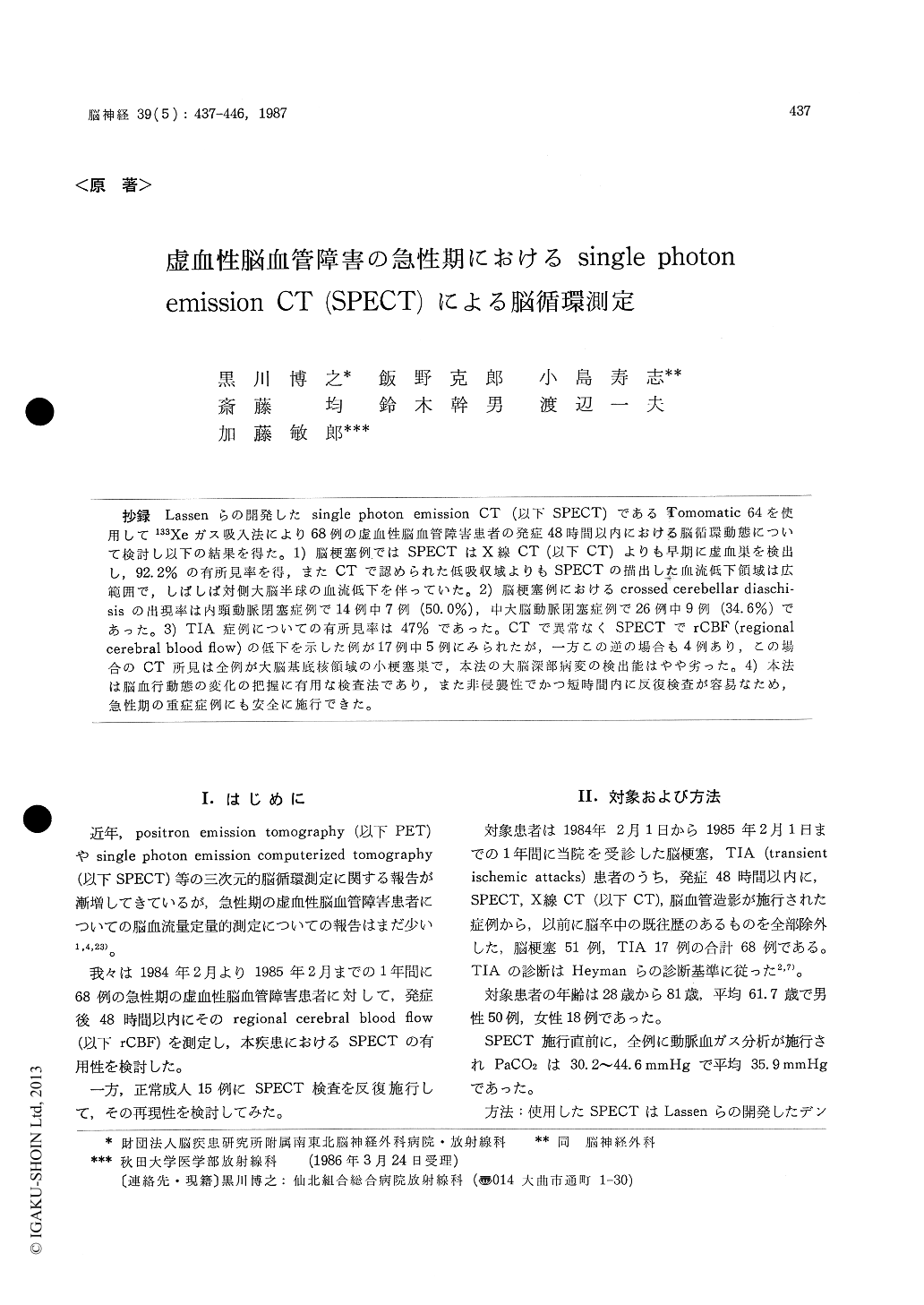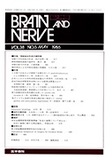Japanese
English
- 有料閲覧
- Abstract 文献概要
- 1ページ目 Look Inside
抄録 Lassenらの開発したsingle photon emission CT (以下SPECT)であるTomomatic 64を使用して133Xeガス吸入法により68例の虚血性脳血管障害患者の発症48時間以内における脳循環動態について検討し以下の結果を得た。1)脳梗塞例ではSPECTはX線CT (以下CT)よりも早期に虚血巣を検出し,92.2%の有所見率を得,またCTで認められた低吸収域よりもSPECTの描出し率血流低下領域は広範囲で,しばしば対側大脳半球の血流低下を伴っていた。2)脳梗塞例におけるcrossed cerebellar diaschi-sisの出現率は内頸動脈閉塞症例で14例中7例(50.0%),中大脳動脈閉塞症例で26例中9例(34.6%)であった。3) TIA症例についての有所見率は47%であった。CTで異常なくSPECTでrCBF (regionalcerebral blood flow)の低下を示した例が17例中5例にみられたが,一方この逆の場合も4例あり,この場合のCT所見は全例が大脳基底核領域の小梗塞巣で,本法の大脳深部病変の検出能はやや劣った。4)本法は脳血行動態の変化の把握に有用な検査法であり,また非侵襲性でかつ短時間内に反復検査が容易なため,急性期の重症症例にも安全に施行できた。
Abstract
The papers about cerebral blood flow (CBF) in patients with cerebrovascular diseases have been already reported by positron emission compute-rized tomography (PET), single photon emission computerized tomography (SPECT), Xray CT (CT) using cold Xe, and so on.
However the literature about the CBF changes in acute stage is few. We studied CBF in 68 patients with ischemic cerebrovascular disease within 48 hours after the onsets from February 1984 through February 1985. CBF was measured by a rapidly rotating single photon emission compute-rized tomography (SPECT) using non-invasive Xenon-133 inhalation method.
Our subjects included 51 cases with cerebral infarction (male 37, female 14, average 62.9 years)and 17 cases with TIA (male 13, female 4, ave-rage 60.5 years), the patients who had a past history of stroke were excluded from the sub-jects. The SPECT was performed with use of To-momatic 64 developed by Dr. Lassen, et al, SPECT and carotid arteriography were simultaneously per-formed within 48 hours in all cases. CT we used were GE CT 9800 scanner and Hitachi HF CT.
The following results have been obtained :
1) SPECT clearly showed an ischemic focus cor-related with clinical symptom after the attack rather than CT, the positive finding by SPECT was 92.2% and that by CT was 62.7% within 48 hours after the onset.
2) The remote effect phenomenon so-called cross-ed cerebellar diaschisis was demonstrated in 7 of 14 cases (50%) with cerebral infarction due to internal carotid artery occlusion and in 9 of 26 cases (34.6%) with that due to middle cerebral artery occlusion.
3) SPECT and CT were performed within 8 hours after the onset in 20 cases with cerebral infarction. SPECT showed decreased CBF in all cases whereas the positive finding by CT was 40.0%. The area of decreased CBF was always larger than the low density area that CT demon-strated. Mean CBF value of the cerebral hemi-sphere in the cases with ICA occlusion within 8 hours after the onsets was 31.0 (ml/100g/min), and that of MCA occlusion was 36.0 (ml/100g/ min), and that of MCA occlusion was 36.0 (ml/ 100g/min).
4) The positive finding by SPECT on TIA cases was 47% and that by CT was 41.1%, SPECT usually did not demonstrate a small ischemic fo-cus especially at the deep region (ie, basal ganglia region).
5) SPECT using Xe-133 inhalation was useful and non-invasive method for the diagnosis in acute stage with ischemic cerebrovascular disease. No side effect was experienced.
The results of the present study suggest that SPECT using Xenon-133 gas may be a promising method to increase our understanding of the me-chanism for ischemic cerebrovascular disease in acute stage through farhter studies of various pathological cases.

Copyright © 1987, Igaku-Shoin Ltd. All rights reserved.


